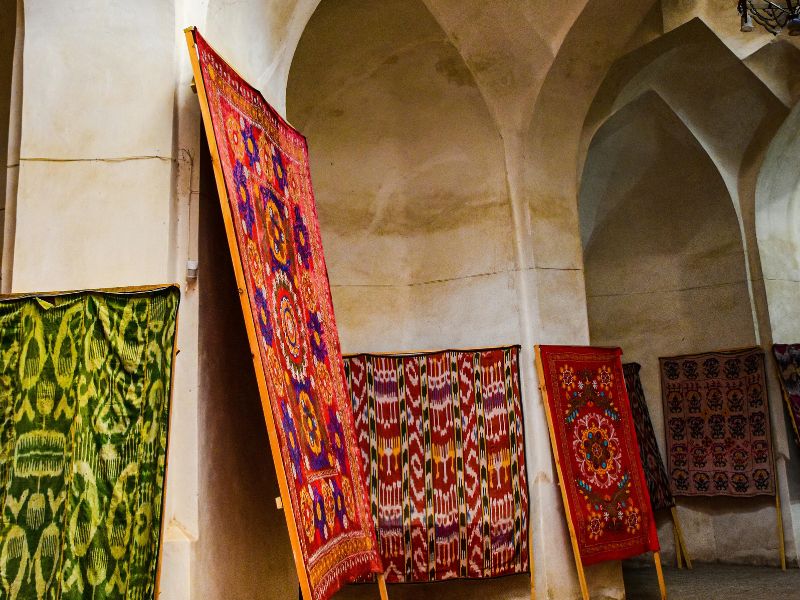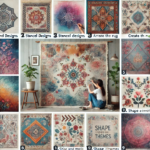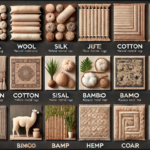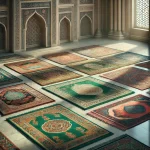Introduction:
Iranian carpets, also known as Persian carpets, are renowned worldwide for their exquisite beauty, intricate designs, and unparalleled craftsmanship. Dating back over two millennia, the art of carpet weaving holds a special place in Iranian culture, reflecting the rich tapestry of history, tradition, and artistic expression. In this article, we will explore the enduring allure of Iranian carpets, delving into their origins, distinctive characteristics, and lasting impact on the world of textile art.
A Legacy of Artistry and Tradition:
The history of carpet weaving in Iran can be traced back to ancient times, with evidence of carpet fragments dating as far back as the 5th century BCE. Over the centuries, carpet weaving evolved into a highly skilled craft, passed down through generations of master weavers and artisans. Iranian carpets are renowned for their meticulous attention to detail, intricate patterns, and vibrant colors, making them treasured works of art coveted by collectors and connoisseurs around the globe.
Distinctive Features and Designs:
What sets Iranian carpets apart is their distinctive designs, which vary widely depending on the region of origin, weaving technique, and cultural influences. From the lush floral motifs of Isfahan to the bold geometric patterns of Bakhtiari, Iranian carpets encompass a diverse range of styles and aesthetics. Common motifs found in Iranian carpets include floral patterns, arabesques, medallions, and pictorial scenes, each imbued with symbolic significance and meaning.
Techniques and Materials:
Iranian carpets are predominantly hand-woven using traditional techniques passed down through generations. The most common weaving technique is the “hand-knotting” method, which involves tying individual knots of wool or silk around the warp threads to create the pile, or surface, of the carpet. Skilled weavers work meticulously, knot by knot, following intricate patterns and designs drawn on graph paper.
Iranian carpets are typically made from high-quality wool, sourced from local sheep breeds known for their softness, durability, and luster. Silk is also used in certain types of Iranian carpets, adding luxurious texture and sheen to the finished product. Natural dyes derived from plants, minerals, and insects are used to achieve the vibrant colors found in Iranian carpets, creating a rich and nuanced color palette that only improves with age.
Cultural Significance and Symbolism:
Beyond their aesthetic appeal, Iranian carpets hold deep cultural and symbolic significance in Iranian society. Carpets are treasured as symbols of wealth, status, and hospitality, often passed down as heirlooms from one generation to the next. They are also used in traditional ceremonies and celebrations, such as weddings and religious festivals, where they play a central role in rituals and customs.
The patterns and motifs found in Iranian carpets are laden with symbolism, reflecting the beliefs, values, and aspirations of the people who create them. For example, the “Tree of Life” motif symbolizes fertility, abundance, and the interconnectedness of all living beings, while the “Garden” motif represents paradise and the eternal cycle of life. Each design tells a story, weaving together the threads of history, mythology, and culture into a tapestry of beauty and meaning.
Preserving a Cultural Heritage:
Despite the passage of time and the challenges of modernization, the art of carpet weaving remains a cherished tradition in Iran, kept alive by master craftsmen and women who continue to practice the age-old techniques passed down through the ages. Today, Iranian carpets are not only treasured for their artistic and cultural significance but also valued for their investment potential and collectible appeal. Whether displayed as a work of art or used as a functional floor covering, Iranian carpets continue to captivate and inspire admirers around the world, serving as a testament to the enduring legacy of craftsmanship, creativity, and cultural identity.
Iranian carpets, also known as Persian carpets, are renowned worldwide for their exquisite beauty, intricate designs, and unparalleled craftsmanship. With a history spanning over 2,500 years, Iranian carpet weaving is one of the oldest and most revered traditions in the world of textile art. In this article, we will delve deeper into the rich diversity of Iranian carpets, exploring the regional variations, unique characteristics, and enduring significance of these timeless treasures.
Regional Variations:
Iran is home to a diverse array of carpet-weaving regions, each with its own distinctive styles, techniques, and traditions. From the lush gardens of Kashan to the rugged mountains of Kurdistan, Iranian carpets exhibit a rich tapestry of regional variations and artistic expressions.
- Tabriz Carpets: Tabriz, located in northwestern Iran, is one of the oldest carpet-weaving centers in the country. Tabriz carpets are renowned for their intricate designs, fine craftsmanship, and luxurious materials. These carpets often feature elaborate medallion motifs, floral patterns, and intricate borders, reflecting the influence of Persian miniature painting and Islamic art. Tabriz carpets are prized for their durability, versatility, and timeless elegance.
- Isfahan Carpets: Isfahan, known as the cultural capital of Iran, has a long and storied tradition of carpet weaving. Isfahan carpets are celebrated for their exquisite beauty, delicate designs, and fine weave. These carpets often feature intricate floral motifs, arabesques, and medallions, rendered in rich, jewel-toned colors. Isfahan carpets are prized for their artistic quality, with each piece bearing the hallmark of master craftsmanship and attention to detail.
- Kashan Carpets: Kashan, situated in central Iran, is famous for its elegant carpets woven from high-quality wool and silk. Kashan carpets are characterized by their graceful floral designs, intricate arabesques, and rich color palette. These carpets often feature intricate curvilinear patterns, inspired by the lush gardens and landscapes of Kashan. Kashan carpets are treasured for their exceptional beauty, durability, and investment value.
- Bakhtiari Carpets: The Bakhtiari tribe, located in the Zagros Mountains of southwestern Iran, is known for its distinctive carpet-weaving tradition. Bakhtiari carpets are characterized by their bold geometric patterns, vibrant colors, and tribal motifs. These carpets often feature diamond-shaped medallions, stylized animals, and intricate border designs, reflecting the nomadic lifestyle and cultural heritage of the Bakhtiari people. Bakhtiari carpets are prized for their rustic charm, durability, and tribal authenticity.
- Qom Carpets: Qom, located in central Iran, is renowned for its luxurious silk carpets woven by skilled artisans. Qom carpets are celebrated for their fine weave, intricate designs, and exquisite craftsmanship. These carpets often feature delicate floral motifs, arabesques, and prayer rug designs, rendered in shimmering silk threads. Qom carpets are prized for their exceptional beauty, softness, and investment value, making them highly sought after by collectors and connoisseurs.
Iranian carpets, often referred to as Persian carpets, stand as a testament to the rich cultural heritage and artistic legacy of Iran. For centuries, Iranian carpet weaving has been celebrated for its exquisite beauty, intricate designs, and meticulous craftsmanship. In this article, we will embark on a journey to uncover the artistry and craftsmanship behind Iranian carpets, exploring the techniques, materials, and cultural significance that make them cherished treasures of the textile world.
The Art of Hand-Woven Carpets:
At the heart of Iranian carpet weaving lies the centuries-old tradition of handcraftsmanship. Unlike mass-produced carpets, Iranian carpets are meticulously hand-woven by skilled artisans who employ age-old techniques passed down through generations. Each carpet is a labor of love, with the weaver devoting countless hours to knotting individual strands of wool or silk onto the warp threads to create intricate patterns and designs.
Hand-knotting is the most common technique used in Iranian carpet weaving, allowing for precise control over the density, texture, and intricacy of the carpet’s pile. Skilled weavers use specialized tools such as a loom, shuttle, and comb to create tight, uniform knots that form the foundation of the carpet’s design. The density of the knots, measured in knots per square inch, is a hallmark of quality craftsmanship, with higher knot counts indicating finer detail and superior workmanship.
Materials and Dyes:
The materials used in Iranian carpet weaving play a crucial role in determining the quality, durability, and aesthetic appeal of the finished product. Wool is the most common material used for Iranian carpets, prized for its softness, resilience, and ability to hold vibrant colors. High-quality wool is sourced from local sheep breeds known for their long, fine fibers, which are spun into yarn and dyed using natural dyes derived from plants, minerals, and insects.
Silk is also used in certain types of Iranian carpets, particularly those crafted for luxury and refinement. Silk threads are prized for their luster, sheen, and ability to create intricate designs with unparalleled clarity and precision. Cotton is used for the warp and weft threads, providing stability and strength to the carpet structure while allowing for smooth, even weaving.
Designs and Motifs:
Iranian carpets are renowned for their diverse range of designs, motifs, and patterns, each reflecting the cultural heritage, artistic sensibilities, and regional influences of the weavers. Common motifs found in Iranian carpets include floral patterns, geometric shapes, arabesques, and pictorial scenes, each imbued with symbolic significance and meaning.
The design process begins with the creation of a detailed pattern, known as a “cartoon,” which serves as a guide for the weaver. Master designers, often referred to as “ustad,” draw the pattern on graph paper, carefully selecting colors, proportions, and motifs to achieve the desired aesthetic. The cartoon is then placed under the warp threads, serving as a visual reference as the weaver knots each strand of yarn according to the design.
Cultural Significance and Symbolism:
Beyond their aesthetic appeal, Iranian carpets hold deep cultural and symbolic significance in Iranian society. Carpets are treasured as symbols of wealth, status, and hospitality, often passed down as heirlooms from one generation to the next. They are also used in traditional ceremonies and celebrations, such as weddings, births, and religious festivals, where they play a central role in rituals and customs.
The motifs and symbols found in Iranian carpets are laden with meaning, reflecting the beliefs, values, and aspirations of the people who create them. For example, the “Tree of Life” motif symbolizes fertility, abundance, and the interconnectedness of all living beings, while the “Garden” motif represents paradise and the eternal cycle of life. Each design tells a story, weaving together the threads of history, mythology, and culture into a tapestry of beauty and meaning.
Preserving a Time-Honored Tradition:
Despite the challenges of modernization and globalization, the art of Iranian carpet weaving continues to thrive, thanks to the dedication and craftsmanship of master artisans and weavers. Today, Iranian carpets are not only treasured for their artistic and cultural significance but also valued for their investment potential and collectible appeal. Whether displayed as a work of art or used as a functional floor covering, Iranian carpets continue to captivate and inspire admirers around the world, their beauty and elegance enduring through the ages.
Conclusion:
Iranian carpets are more than just decorative floor coverings; they are exquisite works of art that embody centuries of tradition, culture, and craftsmanship. From the majestic palaces of Isfahan to the rugged mountains of Kurdistan, Iranian carpets reflect the diverse landscapes, cultural influences, and artistic expressions of the regions where they are created. Whether displayed in museums, homes, or galleries, Iranian carpets serve as a testament to the enduring legacy of craftsmanship, creativity, and cultural identity, captivating and inspiring admirers for generations to come.






